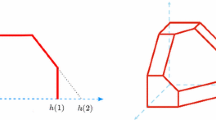Abstract
We analyse the queueQ L at a multiplexer withL inputs. We obtain a large deviation result, namely that under very general conditions
provided the offered load is held constant, where the shape functionI is expressed in terms of the cumulant generating functions of the input traffic. This provides an improvement on the usual effective bandwidth approximation\(P\left[ {Q^L > b} \right] \approx e^{ - \delta b}\) replacing it with\(P\left[ {Q^L > b} \right] \approx e^{ - LI(b/L)}\), The differenceI(b)−δb determines the economies of scale which are to be obtained in large multiplexers. If the limit\(\nu = - \lim _{t \to \infty } t\lambda _t (\delta )\) exists (here λt, is the finite time cumulant of the workload process) then\(\lim _{b \to \infty } (I(b) - \delta b) = \nu\). We apply this idea to a number of examples of arrivals processes: heterogeneous superpositions, Gaussian processes, Markovian additive processes and Poisson processes. We obtain expressions forv in these cases,v is zero for independent arrivals, but positive for arrivals with positive correlations. Thus ecconomies of scale are obtainable for highly bursty traffic expected in ATM multiplexing.
Similar content being viewed by others
References
D. Anick, D. Mitra and M.M. Sondhi, Stochastic theory of a data-handling system with multiple sources, Bell Syst. Tech. J. 61 (1982) 1872–1894.
C. Borell, The Brunn-Minkowski inequality in Gauss space, Invent. Math. 30 (1975) 205–216.
J.A. Bucklew,Large Deviation Techniques in Decision, Simulation and Estimation (Wiley, New York, 1990).
E. Buffet and N.G. Duffield, Exponential upper bounds via martingales for multiplexers with Markovian arrivals, J. Appl. Prob. 31 (1994) 1049–1061.
C.S. Chang, Stability, queue length and delay of deterministic and stochastic queueing networks, IEEE Trans. Autom. Cont. 39 (1994) 913–931.
G.L. Choudhury, D.M. Lucantoni and W. Whitt, Squeezing the most out of ATM, IEEE Trans. Commun., to appear.
T.J. Corcoran, Prediction of ATM multiplexer performance by simulation and analysis of a model of packetized voice traffic, M.Sc. Thesis, Dublin City University (1994).
C. Courcoubetis, G. Kesidis, A. Ridder, J. Walrand and R. Weber, Call acceptance and routing in ATM networks using inferences from measured buffered occupancy, IEEE Trans. Commun. 43 (1995) 1778–1784.
A. Dembo and O. Zeitouni,Large Deviation Techniques and Applications (Jones and Bartlett, Boston-London, 1993).
N.G. Duffield, Exponential bounds for queues with Markovian arrivals, Queueing Systems 17 (1994) 413–430.
N.G. Duffield, Economies of scale in queues with sources having power-law large deviation scalings, J. Appl. Prob., to appear.
N.G. Duffield and N. O'Connell, Large deviations and overflow probabilities for the general single-server queue, with applications, Math. Proc. Camb. Phil. Soc, to appear.
R.S. Ellis,Entropy, Large Deviations, and Statistical Mechanics (Springer, New York, 1985).
A.I. Elwalid, D. Mitra and T.E. Stern, Statistical multiplexing of Markov modulated sources: theory and computational algorithms, in:Teletraffic and Datatraffic in a Period of Change, ITC-13, eds. A. Jensen and V.B. Iversen (Elsevier Science Publ., 1991).
R.J. Gibbens and P.J. Hunt, Effective Bandwidths for the multi-type UAS channel, Queueing Systems 9 (1991) 17–28.
P.W. Glynn and W. Whitt, Logarithmic asymptotics for steady-state tail probabilities in a singleserver queue, J. Appl. Prob. 31A (1994) 131–159.
T.E. Harris,The Theory of Branching Processes (Springer, Berlin, 1963).
J.Y. Hui, Resource allocation for broadband networks, IEEE J. Select. Areas Commun. 6 (1988) 1598–1608.
J.Y. Hui,Switching and Traffic Theory for Integrated Broadband Networks (Kluwer, Boston, 1990).
I. Iscoe, P. Ney and E. Nummelin, Large deviations of uniformly recurrent Markov additive processes, Adv. Appl. Math. 6 (1985) 373–412.
F.P. Kelly, Effective bandwidths at multi-type queues, Queueing Systems 9 (1991) 5–16.
G. Kesidis, J. Walrand and C.S. Chang, Effective bandwidths for multiclass Markov fluids and other ATM sources, IEEE/ACM Trans. Networking 1 (1993) 424–428.
L. Kosten, Stochastic Theory of data handling systems with groups of multiple sources,Proc. 2nd Int. Smyp. on the Performance of Computer Communication Systems, eds. H. Rudin and W. Bux (North-Holland, 1988).
V. Kulkarni and T. Rolski, Fluid models driven by an Ornstein-Uhlenbeck process, Prob. Eng. Inf. Sci. 8 (1994) 403–417.
W.E. Leland, M.S. Taqqu, W. Willinger and D.V. Wilson, On the self-similar nature of Ethernet traffic, ACM SIGCOMM Computer Commun. Rev. 23 (1993) 183–193.
J.T. Lewis and C.-E. Poster, Thermodynamic probability theory: some aspects of large deviations, Russian Math. Surveys (Uspekhi) to appear.
I. Norros, J.W. Roberts, A. Simonian and J. Virtamo, The superposition of variable bitrate sources in ATM multiplexers, IEEE J. Select. Areas Commun. 9 (1991) 378–387.
C. Rasmussen, J.H. Sorensen, K.S. Kvols and S.B. Jacobsen, Source-independent call acceptance procedures in ATM networks, IEEE J. Select. Areas Commun. 9 (1991) 351–358.
R.T. Rockafellar,Convex Analysis (Princeton University Press, Princeton, 1970).
A. Simonian and J. Guibert, Large deviations approximation for fluid queues fed by a large number of on-off sources,Proc. ITC 14, Antibes (1994) pp. 1013–1022.
K. Sriram and W. Whitt, Characterizing superposition arrival processes in packet multiplexers for voice data, IEEE J. Select. Areas Commun. 4 (1986) 833–846.
G. de Veciana, C. Courcoubetis and J. Walrand, Decoupling bandwidths for networks: a decomposition approach to resource management,Proc. IEEE Infocom (1994) pp. 466–474.
A. Weiss, A new technique for analysing large traffic systems, J. Appl. Prob. 18 (1986) 506–532.
W. Whitt, Tail probabilities with statistical multiplexing and effective bandwidths in multi-class queues, Telecom. Syst. 2 (1993) 71–107.
Author information
Authors and Affiliations
Rights and permissions
About this article
Cite this article
Botvich, D.D., Duffield, N.G. Large deviations, the shape of the loss curve, and economies of scale in large multiplexers. Queueing Syst 20, 293–320 (1995). https://doi.org/10.1007/BF01245322
Received:
Revised:
Issue Date:
DOI: https://doi.org/10.1007/BF01245322




